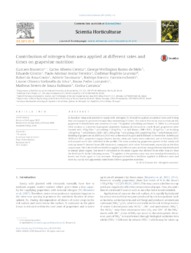Contribution of nitrogen from urea applied at different rates andtimes on grapevine nutrition.
Contribution of nitrogen from urea applied at different rates andtimes on grapevine nutrition.
Autoria: BRUNETTO, G.; CERETTA, C. A.; MELO, G. W. B. de; GIROTTO, E.; FERREIRA, P. A. A.; LOURENZI, C. R.; COUTO, R. da R.; TASSINARIA, A.; HAMMERSCHMITT, R. K.; SILVA, L. O. S. da; LAZZARETTI, B. P.; KULMANN, M. S. de S.; CARRANCA, C.
Resumo: In Brazilian vineyards planted in sandy soils, nitrogen (N) should be applied at optimal rates and timing that correspond to greatest demand, thus minimizing N losses. The aim of this study was to evaluate the grapevine N distribution and recovery of urea-15N applied at budding and bloom. In 2009, in a vineyard (Vitis vinifera cv. Cabernet Sauvignon) planted in Santana do Livramento, south Brazil, grapevines were treated with 10 kg N ha?1 at budding +10 kg N ha?1 at full bloom (10B + 10F); 20 kg N ha?1 at budding +20 kg N ha?1 atfull bloom (20B + 20F); 20 kg N ha?1 at budding (20B); and 40 kg N ha?1 atfull bloom (40F). Budding of grapevines in 2009 and 2010 was atthe end of August and full bloom in November. In February 2010 and 2011, grapevine organs (leaves, berries, stem and roots) were collected, and in February 2011 soil samples were also collected in the profile. The wine-producing grapevines grown in the sandy soil took up more N derived from 20B treatment, compared with other N treatments, especially in the first crop season. The N derived from fertilizer applied at different rates and time was preferentially distributed in annual plant organs, but most N contained in the plant organs was derived from other sources than the fertilizer N. In the following season, 15N applied in the previous year was recovered preferentially in leaves and fruits, again in low amounts. Nitrogen derived from fertilizer applied at different rates and time in a sandy soil apparently contributes little to grapevine nutrition
Ano de publicação: 2016
Tipo de publicação: Artigo de periódico
Unidade: Embrapa Uva e Vinho
Palavras-chave: Cobre, Derived from fertilizer, Plant N, Processo de rizosfera, Práticas agronômicas, Residual soil N, Solo, Solos vitícolas, Uptake, Vitis Vinifera
Observações
1 - Por padrão são exibidas publicações dos últimos 20 anos. Para encontrar publicações mais antigas, configure o filtro ano de publicação, colocando o ano a partir do qual você deseja encontrar publicações. O filtro está na coluna da esquerda na busca acima.
2 - Para ler algumas publicações da Embrapa (apenas as que estão em formato ePub), é necessário ter, no celular ou computador, um desses softwares gratuitos. Sistemas Android: Google Play Livros; IOS: iBooks; Windows e Linux: software Calibre.
Acesse outras publicações
Acesse a Base de Dados da Pesquisa Agropecuária (BDPA) para consultar o acervo completo das bibliotecas da Embrapa.

